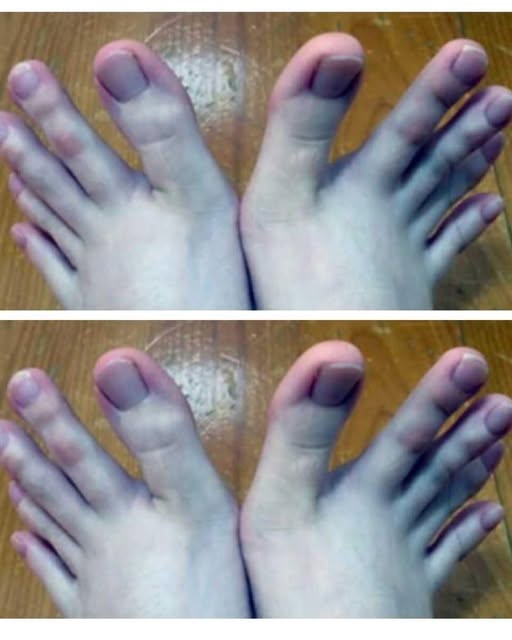In a world where human body diversity continually surprises and fascinates us, a Taiwanese student recently became an unexpected sensation on the internet by sharing pictures of her unusually long toes. Her story quickly captured the attention of many, with some people finding her toes fascinating and unique, while others responded with humor or surprise. Beyond the initial reactions, her experience invites us to explore the broader topic of human physical diversity, the different types of foot shapes, and the question of whether having a longer second toe should be a cause for concern.
Let’s take a deep dive into this captivating tale and use it as a starting point to explore the intriguing world of feet and the fascinating variety of forms they take.
The Remarkable Toe Revelation
The anonymous Taiwanese student first shared photos of her extraordinarily long toes on social media, and it didn’t take long for the images to go viral. What started as a simple post became a conversation about how unusual and interesting her toes looked. From her perspective, she initially believed her toes were normal since both of her parents had similarly long toes. She grew up thinking this was just how feet were supposed to look.
It was only as she got older that she realized her feet were noticeably different from those around her. Her second toe, in particular, stood out—it measured an astonishing two inches longer than the others, which led to many curious and humorous comments online. Some viewers were even confused, mistaking her feet for hands because of their unusual shape and length!
At just 4 feet 11 inches tall, the young woman often struggled to understand why her toes were so distinctive. She shared stories of how strangers would sometimes stare or comment, comparing her toes to animal claws or joking that she must be some kind of prehistoric creature that hadn’t evolved fully. Others even joked that with her “four hands,” she could easily climb trees like a monkey.
Despite the sometimes awkward attention, the student gradually came to embrace her unique toes. She discovered that her elongated toes gave her abilities most people don’t have—like walking on tiptoe silently and locking her toes together in a tight grip. Instead of being embarrassed, she started appreciating the uniqueness and practicality of her toes.
The Fascinating World of Foot Shapes
While the Taiwanese student’s story is certainly eye-catching and rare, it also opens the door to learning about the many different foot shapes that exist. Human feet are wonderfully diverse and come in a variety of forms, each with its own distinct charm and sometimes cultural or symbolic significance.
For centuries, people have classified foot shapes in various ways, often connecting them to personality traits, beauty standards, or even symbolic meanings in different cultures. One of the most well-known foot shape categories is known as “Greek feet,” which is characterized by a longer second toe followed by the other toes in descending order of length.
The student’s feet perfectly fit into this category. Historically, Greek feet have been associated with qualities like creativity, leadership, and even attractiveness. Some classical sculptures and artworks famously display this foot shape, reinforcing its association with beauty and harmony. However, it’s important to understand that these connections are rooted in cultural beliefs and traditions rather than scientific evidence.
Is Having a Longer Second Toe a Concern?
The question many might have after hearing about this student’s elongated second toe is whether it’s something to worry about. The good news is that having a longer second toe—sometimes called Morton’s toe—is actually quite common. Studies estimate that roughly 10 to 20 percent of people have this foot characteristic, making it a natural anatomical variation.
For most people, having a longer second toe doesn’t cause any medical problems or pain and is simply part of their unique anatomy. There’s generally no health risk associated with it, so it’s not something that requires treatment or special attention.
That said, some people with an elongated second toe may experience discomfort, especially if their footwear doesn’t accommodate the shape of their foot properly. Shoes that are too tight or don’t fit well can cause issues like calluses, blisters, or uneven pressure points. If someone experiences these symptoms, it might be helpful to look for shoes designed for wider feet or consult a podiatrist for specialized advice and care.
Celebrating Uniqueness and Diversity
The story of the Taiwanese student and her remarkable toes is more than just a curious internet sensation. It serves as a beautiful reminder of the vast diversity that exists within the human body. Our differences—from toe length to skin color to height—are what make each of us unique.
Her “Greek feet” might catch attention and spark conversations, but they’re just one example of the many variations that define humanity. Having a longer second toe is typically nothing to worry about, but if it ever causes discomfort, seeking professional advice is a wise step.
Ultimately, what matters most is learning to celebrate and embrace the features that make us who we are. Our unique traits tell stories about our heritage, our families, and our individual journeys. They remind us that beauty and worth aren’t defined by conformity but by the richness of diversity.
Since her story went viral, it has inspired many to appreciate their own unique features, whatever they may be. It teaches us that true confidence comes from accepting ourselves fully and recognizing that our differences make the world a more interesting and wonderful place.
